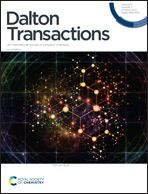Selective perrhenate/pertechnetate removal by a MOF-based molecular trap†
Abstract
A rational design of anion-exchange materials for the selective elimination of radioactive anionic contaminants poses a great challenge. Rather than relying on a size-compatible effect, the combination of a nano-sieve pore, hydrophobic cationic cavity, and soft-acidic open metal sites within one sorbent is an emerging strategy for meeting the requirement. Here, we designed a porous cationic Ag(I) metal–organic framework (MOF), TNU-132, which combined multiple features and showed superior perrhenate/pertechnetate capture selectivity in the presence of a large excess of 300-fold NO3− and 2000-fold SO42−. The mechanism of this high selectivity can be well elucidated by the anion exchange experiments of TNU-132 in the Cr2O72−/ReO4− mixture. That is, the separation process underwent two sequential steps, the nano-sieving procedure and then a reconstruction process in the crystalline sorbent. These results were further confirmed by scanning transmission electron microscopy (STEM), energy-dispersive X-ray spectroscopy (EDS), and/or single-crystal X-ray diffraction (SC-XRD) of oxoanion-loaded materials.



 Please wait while we load your content...
Please wait while we load your content...